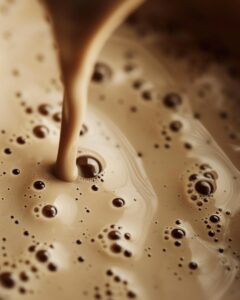Muscadine Wine Recipe: Unlock the Secret to Perfect Flavor
Have you ever wondered how to craft the perfect muscadine wine recipe? You’re in the right place! This guide will walk you through every step to create a wine that’s rich in flavor and aroma. Whether you’re a seasoned winemaker or a beginner, our detailed instructions will help you achieve the best results.
In this recipe:
- Ingredients needed
- Step-by-step instructions
- Pro tips for best results
- FAQs to troubleshoot
First, gather the freshest muscadine grapes you can find. The quality of your grapes will significantly impact the final product. Next, follow our step-by-step instructions to ensure you capture the essence of these unique grapes.
Have you ever tried making jelly? Check out our muscadine jelly recipe for another delightful treat. Additionally, if you’re interested in experimenting with different types of homemade wines, our mead recipe might catch your fancy.
Let’s get started on this exciting journey to making your very own muscadine wine. You’ll soon discover that the secret to perfect flavor lies in the details. Happy winemaking!

Who Can Make This Recipe, Difficulty Level, and What You Need
Whether you’re new to winemaking or have years of experience, this muscadine wine recipe is for you. It’s designed to be approachable yet rewarding, making muscadine wine at home a delightful experience. The difficulty level is moderate, so having some basic wine-making knowledge will definitely help. However, even beginners can achieve excellent results with careful attention to the steps.
Essential Equipment for Easy Muscadine Wine Preparation
Before you start, make sure you have all the necessary equipment. Here’s a quick list:
- A large pot for boiling the grapes
- A fermentation bucket or carboy for fermenting the wine
- A hydrometer to measure the specific gravity
- A siphon or racking cane for transferring the wine
- Wine bottles or jugs for storing the finished product
Having the right tools makes the process smoother and ensures you achieve the best results. If you’re missing any items, you can easily find them at wine-making supply stores or online. For instance, check out this comprehensive guide on essential wine-making equipment to get started.
In addition to the equipment, you’ll need some specific ingredients like wine yeast, pectic enzyme, and sugar. These are crucial for the fermentation process and will help you craft a wine that’s both aromatic and flavorful. Don’t worry if you’re unfamiliar with these terms; our step-by-step instructions will guide you through each part of the process.
By preparing well and understanding the basics, you’ll find that making muscadine wine at home is an enjoyable and fulfilling endeavor. Ready to dive in? Let’s get started!
The Ingredients Needed to Make Muscadine Wine
Now that we’ve covered the minimal equipment you’ll need, let’s dive into the ingredients. Choosing the right ingredients is crucial for the perfect outcome of your muscadine wine. With just a few essential items, you’ll be well on your way to creating a delightful homemade wine.
Your Essential Ingredients
To get started, you’ll need the following ingredients:
- 1 gallon of muscadine grapes: This equates to about 12-15 pounds of fresh grapes. Using fresh grapes ensures the best flavor for your wine.
- 2 pounds of sugar: Sugar is vital for fermentation, providing the yeast with the energy it needs.
- 1 packet of wine yeast: Opt for varieties like Lalvin 71B-1122 or EC-1118 for best results.
- Pectic enzyme: This helps break down the fruit’s pectin, resulting in a clearer wine.
- Acid blend: Adding a teaspoon of acid blend, such as malic or tartaric acid, improves the wine’s flavor.
- Potassium sorbate (optional): This is used to prevent further fermentation and stabilize the wine.
- Yeast nutrient: About 1/2 teaspoon of nutrients like DAP (diammonium phosphate) supports a healthy fermentation process.
- Yeast energizer: Another 1/2 teaspoon of energizer, such as Go-Ferm or FermFast, enhances yeast performance.
With these ingredients at hand, you’re well-equipped to start making muscadine wine from fresh grapes. Each component plays a crucial role, ensuring a smooth fermentation and a flavorful end product. Whether you’re following a traditional muscadine wine recipe or exploring variations, these ingredients form the foundation of a successful batch.
Are you ready to get started? Let’s move on to the step-by-step process of turning these ingredients into delicious homemade wine!

Step-by-Step Guide on How to Make Muscadine Wine
Now that we’ve gathered all the necessary ingredients, it’s time to dive into the exciting process of making your own homemade muscadine wine. Follow these straightforward steps to ensure you achieve the best results.
1. Crush the Grapes and Strain the Juice
Start by washing the muscadine grapes thoroughly. Once clean, crush the grapes to release the juice. You can use a crusher or simply crush them by hand. After crushing, strain the mixture through a strainer or cheesecloth to separate the juice from the pulp. This step ensures a smooth and clean juice for fermentation.
The Fermentation Process
2. Boil the Juice and Dissolve the Sugar
Pour the freshly strained grape juice into a large pot and bring it to a boil. Boil for about 5-10 minutes to help extract the flavors. Remove from heat and allow it to cool to room temperature. Once cooled, add the sugar and stir until completely dissolved. This step is crucial as it provides the necessary sugars for the yeast to convert into alcohol during fermentation.
3. Add Yeast and Ferment the Mixture
Now that your juice is ready, it’s time to introduce the yeast. Sprinkle the wine yeast over the cooled juice and give it a good stir. Allow the mixture to sit for 12-24 hours to activate the yeast. Transfer the mixture to a fermentation bucket or carboy, adding pectic enzyme and acid blend. Ferment at a temperature between 65°F and 75°F for 7-14 days. Use a hydrometer to monitor the specific gravity to ensure proper fermentation.
Following these homemade muscadine wine steps will set you on the path to creating a delightful beverage. Stay tuned for our next section, where we dive into the muscadine wine bottling techniques and how to age your wine to perfection.
Serving and Storing Ideas and Tips
Now that you have successfully made your muscadine wine, it’s time to dive into the fun part – serving and storing your creation. This recipe is accessible to everyone, requiring minimal cooking knowledge or experience. Let’s explore how to best enjoy and preserve your homemade wine.
How to Serve Muscadine Wine
When it comes to serving muscadine wine, the goal is to enhance its unique flavors. Serve the wine at room temperature or slightly chilled. This brings out the fruity and aromatic notes of the muscadine grapes, making each sip delightful. You can also experiment with wine glasses to find the one that best complements the wine’s bouquet. Planning a dinner party? Pair your muscadine wine with cheese, fruit, or light appetizers for a perfect match.
Consider the occasion and your guests’ preferences. A casual evening might call for a simple wine glass, while a more formal event could benefit from a decanter to aerate the wine and elevate the experience. Remember, serving wine is an art, and presentation matters.
Muscadine Wine Storage Tips
Proper storage is crucial for preserving the quality of your muscadine wine. Store the wine in a cool, dark place away from direct sunlight. Consistent temperatures are key, so if you have access to a wine refrigerator or cellar, use it. If not, a dark closet or pantry can work just as well.
Ensure the wine bottles are stored horizontally. This keeps the cork moist, preventing it from drying out and allowing air to enter the bottle. Corked wine bottles should be checked periodically to ensure they remain sealed properly.
For those interested in the muscadine wine aging process, patience is your friend. Aging the wine for 6-12 months can develop deeper, more complex flavors. The wait may be long, but the reward is often worth it.
Now you’re equipped with the best muscadine wine storage tips and serving ideas. Whether you’re enjoying your wine soon or planning to age it, following these guidelines ensures you get the most out of your homemade muscadine wine.

Pro Tips for Perfect Muscadine Wine
- Always use ripe, high-quality muscadine grapes for the best results.
- Monitor the temperature closely during fermentation.
- Use a hydrometer to check specific gravity and track fermentation progress.
- Consider adding a small amount of oak chips for a subtle oak flavor.
- Store your bottled wine in a cool, dark place for better aging.
- Use a wine refrigerator to maintain consistent temperature during storage.
- Experiment with different yeast strains for unique flavor profiles.
- Keep meticulous records of your muscadine wine recipe adjustments.
FAQ – Ingredient Replacement Options, Money-Saving Options, Relevant Tips
Welcome to our FAQ section where we discuss common questions related to making the best homemade muscadine wine. Whether you’re a seasoned winemaker or just getting started, these tips and tricks will help you perfect your muscadine wine recipe.
Ingredient Replacement Options
Q1: Can I use other types of grapes?
A: Yes, you can use other types of grapes, but keep in mind that the flavor will vary. Muscadine grapes have a unique taste that sets them apart from other grape varieties. If you decide to use another type, you may need to adjust the sugar and acid levels to achieve the desired balance. For more on different grape varieties, check out this detailed guide.
Q2: Can I add other fruits or spices?
A: Absolutely! Adding other fruits or spices can create interesting muscadine wine recipe variations. However, it’s crucial not to overpower the natural muscadine flavor. Consider adding subtle hints of berries or spices such as cinnamon. Start with small amounts and adjust to taste.
Q3: How can I check if the wine is fermenting properly?
A: The best way to ensure your wine is fermenting properly is to use a hydrometer. This tool measures the specific gravity of the wine, indicating whether fermentation is occurring. Regularly check the readings to monitor the fermentation process. For more muscadine wine troubleshooting tips, click here.
Money-Saving Options
Q4: Can I use less sugar to save costs?
A: While reducing sugar can save money, it may also impact the final taste and alcohol content of your wine. It’s essential to find a balance that maintains the quality of the wine. Experiment with small batches to find the right amount of sugar that suits your budget and taste preferences.
Q5: Are there cheaper alternatives to commercial wine yeast?
A: Yes, there are more affordable yeast options available. While commercial wine yeasts are formulated for optimal fermentation, you can use baker’s yeast as a cost-effective alternative. However, be aware that it may result in different flavors and fermentation efficiency. For a comprehensive guide on yeast options, visit this link.
By following these tips and exploring ingredient replacement options, you can enjoy making the best homemade muscadine wine without breaking the bank. Happy winemaking!












